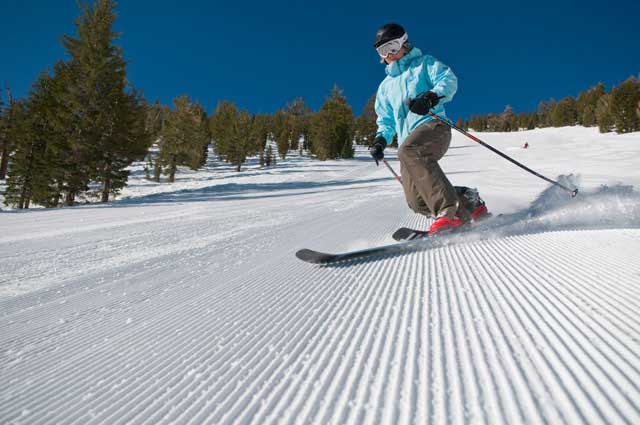Stephen Wood: The men who give winter a helping hand
The man who skis all day

Your support helps us to tell the story
From reproductive rights to climate change to Big Tech, The Independent is on the ground when the story is developing. Whether it's investigating the financials of Elon Musk's pro-Trump PAC or producing our latest documentary, 'The A Word', which shines a light on the American women fighting for reproductive rights, we know how important it is to parse out the facts from the messaging.
At such a critical moment in US history, we need reporters on the ground. Your donation allows us to keep sending journalists to speak to both sides of the story.
The Independent is trusted by Americans across the entire political spectrum. And unlike many other quality news outlets, we choose not to lock Americans out of our reporting and analysis with paywalls. We believe quality journalism should be available to everyone, paid for by those who can afford it.
Your support makes all the difference.Grossinger's Catskill Resort Hotel was once one of the attractions that brought holidaymakers up from New York City to the "Borscht Belt" of the Catskill Mountains. Opened in 1919, it was catering for 150,000 annual guests by the 1970s. But in 1986 the resort closed, and its buildings were abandoned. Since then, they have been slowly sinking into the ground.
This derelict site has an important place in skiing history: it's where the world's first permanent snowmaking facilities were installed, in 1952. The technology for which Wayne M Pierce Jr (who also invented metal-skinned skis) was given a patent in 1950 had its first commercial application at Grossinger's.
Initially, take-up elsewhere was slow, but by the mid-1990s there were said to be 1,200 snowmaking systems in use around the world. Since then snowmaking has, one might say, snowballed. The Canadian resort of Tremblant alone now has more than 1,000 snow cannons; Val d'Isère, where 60 per cent of the slopes are at an altitude of 2,200m or more, nevertheless has snowmaking capacity to cover 60km of pistes. Even the most snow-sure resorts use dense, man-made snow to create a foundation for heavily skied terrain.
Since snowmaking provides the closest thing there is to a guarantee of skiing, resorts trumpet the capability of their equipment for simulating snowfall. The specialists who operate the machinery rarely get a mention; but Colorado Ski Country USA, the professional organisation for that state's ski business, annually honours its best snowmaker. I asked Adam Makela, a 25-year-old boarder who works at Eldora, just west of Boulder, what it took for him to win the 2010 award.
"To do the job at all, you have to have your heart in the sport, because the physical strain and the working hours take their toll," he says. "But I was nominated for good working practices: putting safety first, making a quality product, and operating efficiently."
Hard work – up a mountain, in extreme cold, at night – is a constant. But the snowmaking part, says Makela, "involves a lot of variables". The notion that when the temperature goes below freezing point you simply fire out compressed air and water is soon dispelled once he gets onto the subject of "wet-bulb temperature". It turns out that relative humidity is critical (low is good, high is bad) in snowmaking, as are cannon settings and placement, and "micro-management of the plume" to make drier snow. At a relatively small ski area such as Eldora, efficiency is essential, too: "In the big resorts they make a pile of snow and then spread it around, but we make it on the runs, where it's needed," Makela says.
What about quality control? "You have to ride the product, sure, to check it out. Like I said, your heart's got to be in the sport to do this job."
The history of piste-grooming also goes back to 1952, when one of the founders of Colorado's Winter Park rigged up a sort of plough to be towed by a tractor to smooth bumps in the snow. Reflecting what is now another essential aspect of modern skiing, Colorado Ski Country annually selects a best groomer, too; the current holder of the title is Dick Dreyer, who has been working nights on the slopes of the A-Basin area for 32 years. "Long enough to have made every possible mistake," he says. A gentle, long-haired man who came to Colorado for a Grateful Dead concert and never went home, Dreyer does not lack humility: he got the award "for years of service, I think"; and his best quality as a groomer is, he says, "patience". When pressed, he admits that the fact that A-Basin has the highest ski terrain in North America might have helped him win the award (for which he was runner-up in 2009). Nevertheless, he reckons the days when putting a smooth, corduroy finish on the snow was really difficult are in the past, "when we drove glorified 4WD vehicles towing primitive cutting and grooming. In today's PistenBully snowcats I could work with my feet up on the dashboard".
Join our commenting forum
Join thought-provoking conversations, follow other Independent readers and see their replies
Comments